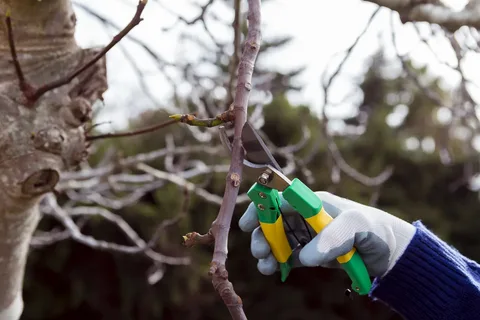Tree trimming is one of the most important maintenance tasks for homeowners and property managers. It not only improves the overall appearance of trees but also keeps them strong, prevents disease, and reduces safety hazards. Properly trimmed trees can live longer, grow healthier, and enhance the value of your property.
Without regular trimming, trees may develop weak branches, attract pests, or obstruct driveways, sidewalks, and utility lines. Dead limbs can break off unexpectedly, causing serious injuries or damage to structures. If left unchecked, overgrown trees can also interfere with sunlight, affecting the growth of nearby plants.
The Benefits of Tree Trimming
Trimming trees does much more than make your yard look neat. It promotes overall tree health, improves safety, and helps maintain an attractive landscape.
Encourages Healthy Growth
Tree trimming removes dead, weak, or diseased branches, allowing the tree to direct its energy toward healthier limbs. This promotes balanced growth and prevents disease from spreading. Without regular trimming, trees can become too dense, making them more vulnerable to pests and fungal infections.
Improves Safety
Overgrown branches can create hazards by obstructing views, interfering with power lines, or breaking during storms. Weak branches can fall without warning, causing injuries or property damage. Regular trimming eliminates these risks by keeping trees structurally sound.
Boosts Curb Appeal
Well-maintained trees enhance the overall aesthetic of a property. Trimming helps shape trees in a visually appealing way, creating a clean and organized landscape. Whether you want to improve your home’s appearance or attract potential buyers, properly trimmed trees add to the beauty of your yard.
Prevents Property Damage
Storms and strong winds can easily break weak branches, which can fall onto roofs, cars, fences, or nearby structures. Trimming reduces the chances of branches becoming projectiles during bad weather. Additionally, the roots of untrimmed trees can spread excessively, damaging sidewalks and driveways.
Supports Fruit Production
For fruit-bearing trees, regular trimming is essential for maximizing yield. It increases sunlight penetration and air circulation, allowing fruit to grow healthier and more abundant. Without proper trimming, branches may become overcrowded, leading to poor fruit quality and reduced production.
When Is the Best Time to Trim Trees?
Trimming trees at the right time is just as important as using the right techniques. Poor timing can lead to stress, stunted growth, or increased vulnerability to diseases. Here’s a guide on when to trim trees for the best results.
Winter (Dormant Season) – Best Time for Most Trees
The ideal time for trimming is during late winter when most trees are dormant. Trimming at this time allows trees to heal quickly before the growing season begins in spring. The absence of leaves also makes it easier to see the tree’s structure, helping you identify which branches need trimming.
Spring and Summer – Light Trimming Only
During spring and summer, trees are actively growing. Trimming should be minimal, focusing only on removing dead or weak branches. Avoid major cuts, as trees are using their energy for new growth. Heavy trimming during this time can stress the tree and slow its development.
Fall – Not Recommended
Fall is generally the worst time for trimming. Trees heal more slowly in colder months, making them more susceptible to diseases and infections. Fungi and decay spread more easily during fall, so it’s best to wait until winter for major trimming.
How to Trim Trees Correctly
Trimming trees requires precision, the right tools, and proper technique. Making incorrect cuts can weaken the tree, invite disease, or result in uncontrolled regrowth. Follow these steps to trim your trees safely and effectively.
Use the Right Tools
Having the proper equipment makes trimming easier and ensures cleaner cuts. Basic tools include:
- Pruning Shears – Ideal for small branches and fine cuts
- Loppers – Suitable for thicker branches
- Pruning Saw – Used for large limbs
- Pole Pruner – Helps reach higher branches
Always ensure your tools are sharp and clean. Dull blades can tear the bark, making it harder for trees to heal.
Identify the Branches to Cut
Before making any cuts, assess the tree and identify which branches should be removed. Focus on:
- Dead or diseased branches
- Weak limbs that could break easily
- Branches crossing or rubbing against each other
Cut at the Right Spot
Avoid cutting branches too close to the trunk. Make cuts just outside the branch collar—the swollen area where the branch connects to the tree. This allows the tree to heal properly without exposing it to infections.
Trim in Stages
For larger branches, follow the three-cut method:
- Make a small undercut a few inches away from the trunk.
- Cut from the top slightly further out.
- Remove the remaining stub at the branch collar.
This method prevents bark from tearing and reduces stress on the tree.
Avoid Over-Pruning
Removing more than 25% of a tree’s branches at once can cause severe stress. Trees need a certain amount of foliage for photosynthesis, so cutting too much can hinder growth.
Common Mistakes to Avoid
Even experienced homeowners can make mistakes while trimming trees. Here are some common errors and how to avoid them.
Topping the Tree
Cutting off the top of a tree weakens its structure and leads to excessive, weak regrowth. This makes the tree more vulnerable to breaking in storms.
Cutting Too Close to the Trunk
Removing a branch flush with the trunk prevents proper healing. Always cut just outside the branch collar to promote natural wound closure.
Ignoring Dead Branches
Leaving dead branches in place can cause disease to spread, attracting pests and further weakening the tree.
Trimming Too Frequently
Trimming too often prevents trees from growing naturally. It’s best to trim only when necessary and follow seasonal guidelines.
Should You Trim Trees Yourself or Hire a Professional?
Tree trimming can be done as a DIY project for small trees, but large trees require professional expertise. Here’s a comparison:
DIY Tree Trimming
Suitable for small trees
Requires basic tools
Must follow safety guidelines
Hiring a Professional
Necessary for large trees or hazardous areas
Ensures precise cuts for tree health
Reduces risk of injury and property damage
If you’re unsure about tree trimming, consulting an arborist is always a safe choice.
Final Thoughts
Tree trimming is a vital part of landscape maintenance. It promotes healthy growth, prevents hazards, and improves property value. By trimming trees at the right time and using proper techniques, you can ensure long-term tree health.
Need professional tree trimming? Contact an expert today to keep your trees healthy and your yard looking its best!





